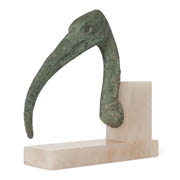Details
- Object type
model
- Place Associated
Egypt (place made)
- Date
Late Period (747–332 BC)
- Materials
bronze
- Dimensions
Ibis on marble base: 219 mm x 211 mm x 64 mm 2771 g
- Description
-
The Egyptian god Thoth was considered to be, amongst other things, the deification of wisdom and scribal knowledge and was often portrayed as an ibis-headed man or as an ibis or baboon.
Contrary to popular opinion, Ancient Egyptians did not worship animals because they were animals. They venerated them because they were believed to be manifestations of the god or goddess associated with that animal. They made vast numbers of sculptures and images of their gods in the form of a hawk ( the god Horus), pregnant hippo (Taweret), baboon or ibis (Thoth) plus many others. In addition to creating these artworks, the ancient Egyptians would present votive offerings to their gods at temple and sacred sites. These often took the form of gifts of mummified animals sacred to the gods.
During the first millennium BC, millions of ibis were reared and then killed, mummified and dedicated to Thoth at temples and sacred sites where enormous cemeteries of these mummified remains have been found.
Some offerings took the form of mummified remains simply wrapped in linen bandages while other more prestigious votives were placed in containers taking the shape of the animal inside. This is the head and neck from a large bronze votive ibis which must have been of considerable size and therefore a significant offering to the god Thoth probably during the Late Period (747–332 BC).
Provenance: George Eumorfopoulos, London before 1940; Sotheby’s 5 June 1940 Lot 146, HRN Norton, London: GF Williams, London; from whom purchased by Sir William Burrell on 27 September 1949.
- Credit Line/Donor
Gifted by Sir William and Lady Burrell to the City of Glasgow, 1944
- Collection
Burrell Collection: Egyptian Items
- ID Number
13.187
- Location
Burrell Collection


